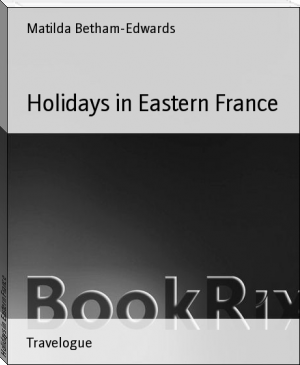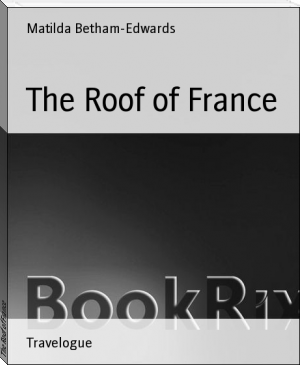Holidays in Eastern France by Matilda Betham-Edwards (free romance novels .txt) 📕

- Author: Matilda Betham-Edwards
Book online «Holidays in Eastern France by Matilda Betham-Edwards (free romance novels .txt) 📕». Author Matilda Betham-Edwards
After climbing for an hour we suddenly begin to descend, our road sweeping round the mountain sides with tremendous curves for about two hours or more, when all of a sudden we seemed to swoop down upon St. Claude, the little bishopric in the heart of the mountains. The effect was magical. We appeared to have been plunged from the top of the world to the bottom! In fact, you go up and down such tremendous heights in the Jura that I should think it must be much like travelling in a balloon.
CHAPTER XI.
ST. CLAUDE: THE BISHOPRIC IN THE MOUNTAINS.
I was prepared to be fascinated with St. Claude, to find it wholly unique and bewitching, to greet it with enthusiasm, and bid it farewell with regret. It has been described so glowingly by different writers--alike its history, site, and natural features are so curious and poetic, such a flavour of antiquity clings to it, that perhaps no other town in the Jura is approached with equal expectation. Nor can any preconceived notion of the attractiveness of St. Claude, however high, be disappointed, if visited in fine weather. It is really a marvellous place, and takes the strangest hold on the imagination. The antique city, so superbly encased with lofty mountains, is as proud as it is singular, depending on its own resources, and not putting on a smile to attract the stranger. Were a magician to sweep away these humming wheels, hammering mill-stones, gloomy warehouses, and put smiling pleasure-grounds and coquettish villas in their place, St. Claude might become as fashionable a resort as the most favourite Swiss or Italian haunts. But in its present condition it does not lay itself out to please, and the town is built in the only way building was possible, up and down, on the edge of the cliffs here, in the depths of a hollow there, zig-zag, just anyhow. High mountains hem it round, and two rivers run in their deep beds alongside the irregular streets, a superb suspension bridge spanning the Valley of the Tacon, a depth of fifty yards. Higher up, a handsome viaduct spans the Valley of La Bienne, on either side of these two stretch clusters of houses, some sloping one way, some another, with picturesque effect. To find your way in these labyrinthine streets, alleys, and terraces is no easy matter, whilst at every turn you come upon the sound of wheels, betokening some manufactory of the well-known, widely imported St. Claude ware, consisting chiefly of turnery, carved and inlaid toys, and fancy articles in wood, bone, ivory, stag's horn, &c. Small hanging gardens are seen wherever a bit of soil is to be had, whilst the town also possesses a fine avenue of old trees turned into a public promenade. St. Claude is really wonderful, and the more you see of it the more you are fascinated. Though far from possessing the variety of artistic fountains of Salins, several here are very pretty and ornamental--notably one surrounded with the most captivating little Loves in bronze, riding dolphins. The sight and sound of rippling water everywhere are delicious; rivers and fountains, fountains and rivers, everywhere! whilst the summer-like heat of mid-day makes both all the more refreshing. St. Claude has everything--the frowning mountain-crests of Salins, the pine-clad fastnesses of Champagnole, the romantic mountain walls of Morez, sublimity, grace, picturesqueness, grandeur, all are here, and all at this season of the year embellished by the crimson and amber tints of autumn.
What lovely things did I see during an hour and a half's walk to the so-called Pont du Diable! Taking one winding mountain road of many, and following the clear winding deep green river, though high above it, I came to a scene as wild, beautiful, and solitary as the mind can picture, above bare grey cliffs, lower down fairy-like little lawns of brightest green, deeper down still, the river making a dozen cascades over its stony bed, and round about the glorious autumn foliage, under a cloudless sky. All the way I had heard, mingled with the roar of the impetuous river, the sound of mill-wheels, and I passed I know not how many manufactories, most of which lie so deep down in the heart of the gorges that they do not spoil the scenery. The ugly blot is hidden, or at least inconspicuous. As I turn back, I have on one side a vast velvety slope, sweeping from mountain to river, terrace upon terrace of golden-green pasture, where a dozen little girls are keeping their kine; on the other steep limestone precipices, all a tangle of brushwood, with only here and there a bit of scant pasturage. The air is transparent and reviving, a south wind caresses us as we go, nothing can be more heavenly beautiful. The blue gentian grows everywhere, and, as I pursue my way, the peasant-folks I meet with pause to say good-day and stare. They evidently find in me an outlandish look, and are quite unaccustomed to the sight of strangers.
I had pleasant acquaintances provided for me here by my friend, the schoolmaster's wife at Morez, and a very agreeable glimpse I thus obtained of French middle-class life; Catholic life, moreover, but free alike from bigotry and intolerance. Very light-hearted, lively, and well-informed were these companions of my walks at St. Claude, among them a government official, his young wife, sister, and another relation, who delighted in showing me everything. We set off one lovely afternoon for what turned out to be a four hours' walk, but not a moment too long, seeing the splendour of weather and scenery, and the amiability of my companions. We took a road that led from the back of the Cathedral by the Valley of the Tacon, a little river that has its rise in the mountain near, and falls into the Flumen close by. It is necessary to take this walk to the falls of the Flumen in order to realize fully the wonderful site of St. Claude, and the amazing variety of the surrounding scenery. Every turn we take of the upward curling road gives us a new and more beautiful picture. The valley grows deeper and deeper, the mountains on either side higher and higher, little chalets peeping amid the grey and the green, here perched on an apparently unapproachable mountain-top, there in the inmost recess of some rocky dell. As we get near the falls, we are reaching one of the most romantic points of view in all the Jura, and one of the most striking I have ever seen, so imposingly do the mountains close around us as we enter the gorge, so lovely the scene shut in by the impenetrable natural wall; for within the framework of rock, peak, and precipice are little farms, gardens, and orchards--gems of dazzling green bathed in ripest sunshine, pine-forests frowning close above these islets of luxuriance and cultivation, dells, glades, and open, lawny spaces between the ramparts of fantastically formed crags and solitary peaks, a scene recalling Kabylia, in the Atlas mountains, but unlike anything except itself. All was still, except for the roar of the tiny river and the occasional sound of timber sliding from some mountain slope into the valley below. The timber is thus transported in these parts, the woodman cutting the planks on some convenient ledge of rock, then letting it find its way to the bottom as best it can. All day long you see the trunk-cutters at work on their airy perches, now bright stairs of gold-green turf, soon to be enveloped in impenetrable masses of snow, and hear the falling planks. As we climb, we are overtaken by two timber carts, and the drivers, peasant-folks from the mountains, are old acquaintances of my companions, and suggest that the ladies should mount. We gladly do so, to the great satisfaction of the peasants, who on no account would themselves add to their horses' burden. It would have been an affront to offer these good people anything in return for their kindness. They were delighted to chat behind with Monsieur, whilst their horses, sure-footed as mules, made their way beside the winding precipice. These peasants had intelligent, good countenances, and were excellent types of the Jura mountaineer.
Having passed a tunnel cut through the rock, we soon reached the head of the valley, the end of the world, as it seems, so high, massive, and deep is the formidable mountain wall hemming it in, from whose sides the little river Tacon takes a tremendous leap into the green valley below; and not one leap, but a dozen, the several cascades uniting in a stream that meanders towards St. Claude. Before us, high above the falls, seeming to hang on a perpendicular chain of rocks, is a cluster of saw-mills. It is not more the variety of form in this scene here than the variety of colour and tone that makes it so wonderful. Everywhere the eye rests on some different outline, colour, or combination.
Would that space permitted of a detailed account here of all else that I saw in this ancient little bishopric in the mountains! St. Claude, indeed, deserves a chapter, nay, a small volume to itself; there is its history to begin with, which dates from the earliest Christian epoch in France; then its industries, each so curious in its details; lastly, the marvellous natural features of its position, a wholly unique little city is this, compared by Lamartine to Zarcle in the forests of Lebanon, and described by other Franche-Comte writers in equally glowing terms. The famous Abbey of St. Claude was visited by Louis XI in order to fulfil a vow still mysterious in history. This was under the regime of its eighty-sixth Abbot, Peter Morel, but, after a period of almost unequalled glory and magnificence, fire, pillage, and other misfortunes visited it from time to time, till the suppression of the Abbey in 1798. I went into the Cathedral with two charming young married ladies, whose acquaintance I had made during my stay, and, leaving them devoutly on their knees, inspected the beautiful and quaint stalls in carved wood of the choir; these are worth a day's study, and unfortunately are not to be had in photography, for some reason or other no photographs being permitted. Here the spirit of the Renaissance has had full play, and you find comedy mixed with pathos, practical good sense with Biblical solemnity, quaintness, beauty, grace, drollery, all in one. The middle statues in bold relief are those of the early Kings of France and the Abbots of St. Claude, besides many noteworthy saints and martyrs, among these St. Denis with his head in his hand, St. Sebastian pierced with arrows, and others. The upper series, on a smaller scale, represents allegorical subjects, some of which are treated in a curiously homely and practical manner, for instance, the figure of Adam holding the apple in his hand with a look as much as to say, "This is what has ruined me;" Eve, in the next compartment, looks somewhat nonchalant, rather a coquette than a penitent. In some of these Biblical scenes the figures are naively dressed in mediaeval garb, but many of them have great beauty and pathos. The under-pieces of the seats, cornices, and





Comments (0)